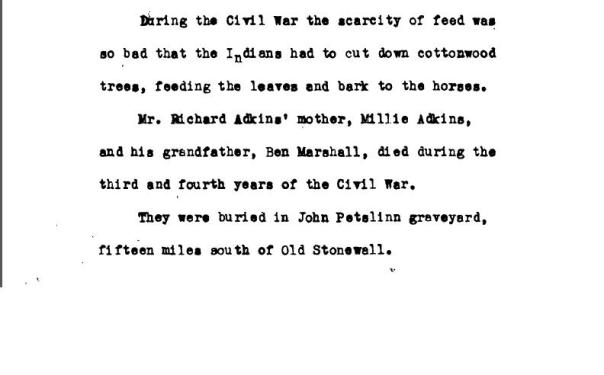Lee Adkins or Why We Don’t Challenge Crazy Gunmen
Richard Adkins, my Grandmother Flora Hardin’s grandfather, had several siblings. He doesn’t mention in his interviews nor in his court testimony if he knew any of his siblings other than Lee Adkins. Lee Adkins was the child of Thomas Adkins and Mary Jane Davis and Richard Adkins testifies that he sent money to Lee Adkins’ widow when Lee died.
Lee Adkins was born in approximately 1857, six years after Richard Adkins was born. Richard Adkins gave testimony regarding his siblings.
So, Richard Adkins didn’t know Billy Adkins or Nancy Adkins (two of his siblings, same father different mother) but he says the last time he’d seen him, Richard Adkins had been in the town where Lee Adkins was raised. He acknowledged that Lee had sisters but not that he knew them nor recognized them as his own siblings. Richard Adkins had received two or three letters from Lee Adkins, Lee Adkins’ wife wrote Richard after his death, and Richard sent money to help with his tombstone.
I have also found testimony in another case that indicates that Richard Adkins had one full sibling. That sibling is listed as Elmira Adkins. Now, why he wouldn’t have mentioned her anywhere is strange to me. He is very clear that when they left during the war, he was with his grandmother, grandfather, an aunt, his mother and himself. No mention of a sister at all.
Apparently Thomas Adkins was legendary. Here is testimony given by Chief Pleasant Porter regarding Richard Adkins’ father, Thomas Adkins.
So Thomas Adkins was a pretty wild sort of fellow. That might have been the understatement of the century.
Poor Lee Adkins. His life comes to a tragic end on the streets of Checotah, Indian Territory. Checotah was a town named for Chief Samuel Checote, a full blood Muskogee Creek Indian, Methodist minister, and the first principal chief of the tribe after the Civil War. Checotah also happens to be where Carrie Underwood, the country singer, was raised.
So while this article is difficult to read, this is a copy of the November 19, 1894 Muscogee Phoenix Newspaper account of the murder of Lee Adkins. Lee Atkins was shot by Amos McIntosh after 7:00 in the evening.
Reports were conflicting but most people agreed that horse races had been held in Checotah that day and that alcohol had been consumed. A gentleman by the name of Mr. Cresswell was passing by the Bumgarner Hotel and saw two men standing near a tree next to the hotel. Not wanting to get involved, as he could tell they had been drinking and trouble was brewing, he continued on his way, saying he didn’t have time to stop. As he came back by the same location, there was a man lying on the platform in front of the billiard hall, the man groaning and calling out “I am killed, I am killed.”
How sad. Just 37 years old, Lee Adkins died of his second gun shot, about 12 hours after he was hit.
I found an additional newspaper article for this incident that claimed Lee Adkins had called Amos McIntosh a coward and dared him to shoot, saying Amos didn’t have the guts to pull the trigger.
If you take no other lesson from this story, please take this. Never dare someone to shoot you.
The gunman Amos McIntosh took a train to Eufaula just after the shooting, where a witness heard him say Lee Adkins was gunning for him but that Amos was too quick for Lee and got off a shot first. They had both been drinking but was not “crazy drunk”. Amos McIntosh and Lee Atkins were Creek citizens of prominence. McIntosh had served as a prosecuting attorney for the Eufaula and Muskogee districts. Lee Atkins had served the past year as a cattle inspector and was a candidate before the recent council as permit inspector. Lee Adkins lived in Eufaula until two years before his death, when he went to Muskogee and ran the billiard hall for a year before returning to Eufaula. Lee Adkins was popular in Eufaula and his friends were outraged at his killing.
Amos McIntosh was taken into custody and turned over to the police in Ft. Smith, Arkansas. Lawmakers at Fort Smith refused to charge Amos McIntosh and thus he was turned over to the Muscogee Creek Lighthorse Brigade. Amos McIntosh was eventually freed and no charges were brought against him.
At the time of his death, Lee Atkins was a newly appointed U.S. Deputy Marshal.
This is the Indian Territory Checotah Cemetery, where Lee Adkins was the first person to be buried.
A lot of the information I found lists Lee Adkins as Lee Atkins. Their surname is spelled both ways and Richard Adkins himself had no idea which was correct. He testified that he was uncertain but thought that his father had spelled it Adkins.
I am still researching Lee Adkins…I wonder what happened to his wife, if he had children and any other juicy tidbits that I can find. Until next time…
The excerpts from the interviews were reproduced with permission from












